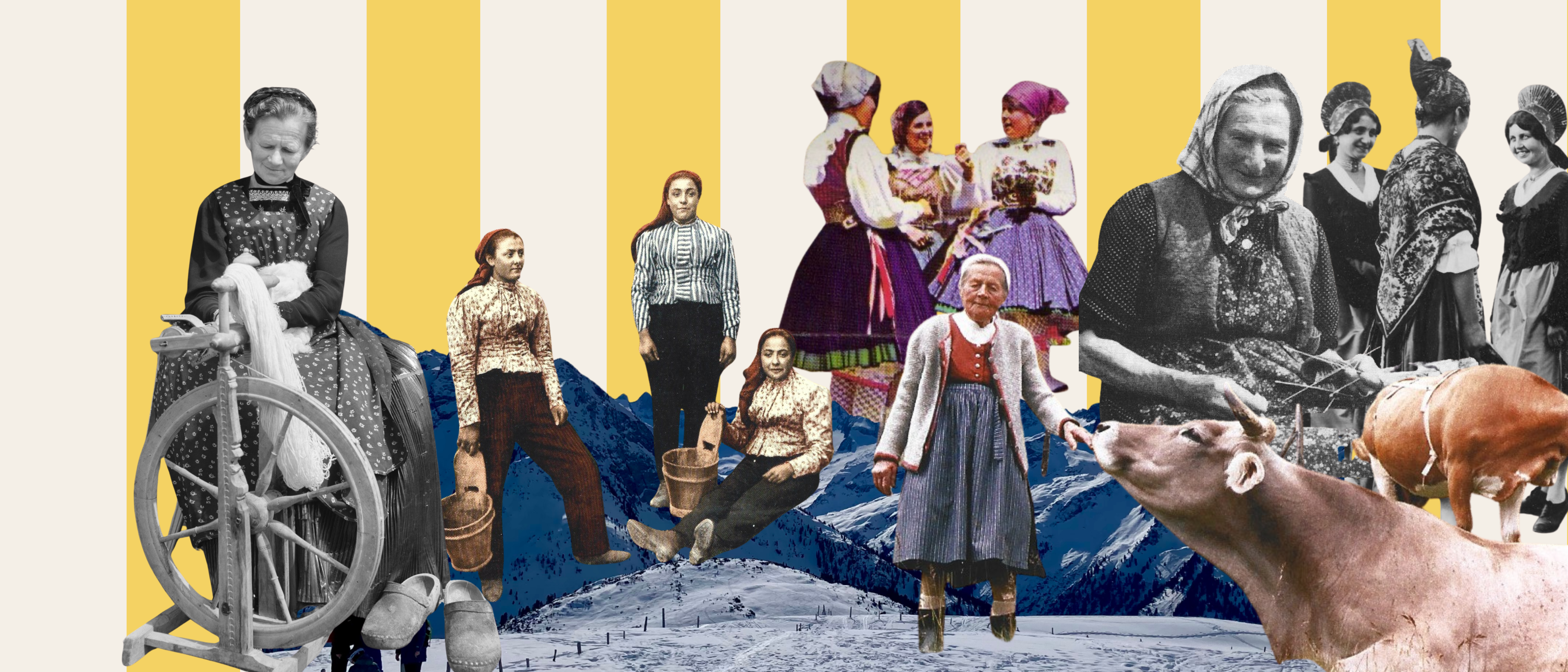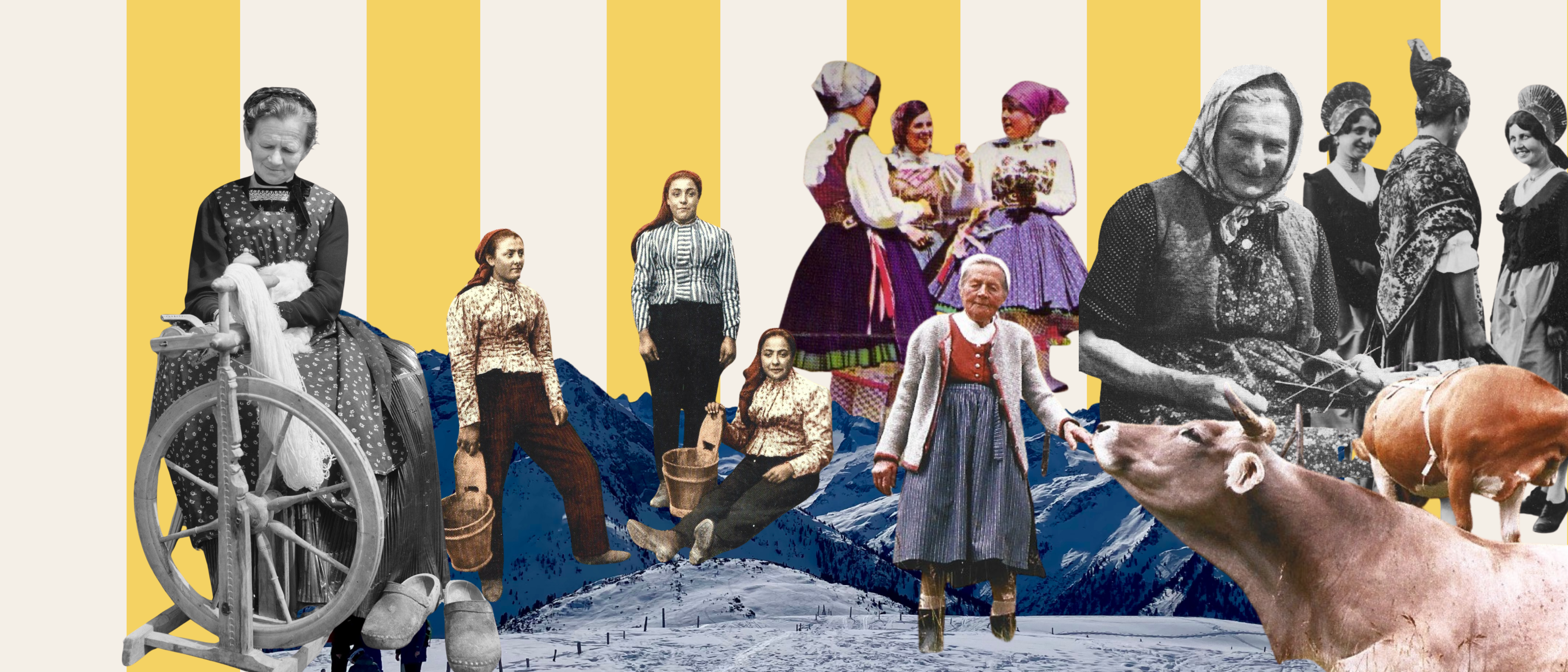Knit Your Roots: Alpine Tracht, Heritage, and the Poetry of Stitches
The Living Splendor of Alpine Tracht
Our knits are not trends. They are heirlooms — born from the centuries-old Alpine culture of “Tracht” and knitting, where every stitch carried meaning and every garment was a declaration of identity. From Bavarian stockings patterned like mountain streams to Tyrolean sweaters shaped by valleys and seasons, Alpine knitting has always been more than craft: it is inheritance, memory, and belonging.
At Michaela Buerger, we carry this lineage forward. Each piece is a modern echo of the twisted stitches, sculptural patterns, and festive costumes that once defined life in the Alps. They are heritage knits — rooted in ritual, alive with history, and made to be cherished for generations.
Traditional costumes – or “Tracht” – are not mere relics of the past. They are cultural assets, living vessels of Alpine memory, each stitch carrying centuries of ritual, resistance, and identity. To put on a dirndl or a Joppe is not simply to dress — it is to step into history, to embody a world where fabric was language, where color was code, and where the mountains themselves were woven into every seam.
Nietzsche and the Antithesis of Fashion vs. Costume
In 1876, Friedrich Nietzsche sharpened the contrast between fashion and costume. He saw modern dress — the sober men’s suit — as the garb of an enlightened European: rational, industrious, hygienic, stripped of ostentation. Costume, to him, belonged to the realm of superstition and rural ignorance, the vestige of a world yet untouched by progress.
And yet, Nietzsche’s dismissal revealed something deeper. For what he called *anachronism* was, in truth, a countercurrent: Tracht as resistance against uniformity, against the anonymity of the modern city. Where the suit sought to erase individuality, Tracht exalted it — showing not only class and profession but also origin, marital status, and devotion. It was an antidote to invisibility.
What You Wear is Who You Are
The word “Tracht” comes simply from “tragen” — to wear. It meant nothing more, at first, than “what you wear every day”. Work clothes, festival clothes, wedding clothes. Yet within these garments lay encyclopedias of information: embroidered bodices that revealed wealth, ribbons that marked a woman as married or widowed, leather pants cut to endure generations of mountain labor. A costume was a declaration — of place, of belonging, of the human condition itself.
The first depictions of Tracht appear on Roman-Celtic gravestones from the 2nd and 3rd centuries. From then until the 19th century, Alpine valleys — isolated, slow to change — developed their own visual dialects. Every village had its codes: the buttons of one town bore no resemblance to the embroidery of the next. Cortina d’Ampezzo had its own Joppe, utterly different from St. Moritz or Courchevel. The Alps became a patchwork of wearable landscapes, each valley a museum of fabric and form.
The Longing for Authenticity
As Europe industrialized, Tracht did not vanish — it transformed. In cities, the wearing of Tracht became an act of nostalgia, even defiance. The more factories grew, the more people longed for untouched rural life. Dirndl and Lederhosen became symbols of idyll, of authenticity, of an imagined world without alienation. Wearing Tracht was a way to reconnect with soil, with sensuality, with something unmechanized.
We might say today: the more digital our lives, the more we hunger for materiality. Just as we crave sourdough bread after processed food, we crave wool, linen, and embroidery after pixels and polyester.
Shadows of the 20th Century
No story of Tracht can ignore its darkest chapter. In the 1930s, Gertrude Pesendorfer — appointed “Reich Representative for German Traditional Costume” — standardized Tracht and elevated the dirndl as propaganda. A “German Dirndl” was designed to embody health, fertility, and obedience, weaponized against the so-called decadence of modernity. In this distortion, Tracht was co-opted into ideology, stripped of its nuance and individuality.
It took decades to free Alpine costume from this shadow. But garments, like landscapes, outlast regimes. Slowly, the dirndl and lederhosen returned to their true place: symbols of Alpine resilience, artistry, and sensual joy.
The Story of Alpine Knitting
If Tracht is the architecture of Alpine clothing, knitting is its quiet poetry — soft, intimate, and intimately tied to life in the mountains.
In the high valleys of Austria and Bavaria, where winter stretches endlessly and the air carries the scent of woodsmoke and pine, knitting grew beyond necessity. It became a language of memory, connection, and devotion — each stitch a tribute to place and family.
Knitting traditions in this region date back to the 13th century, beginning with practical stockings and hats that were nonetheless full of character. Over time, villages found their own voices: delicate lace in Vienna, embroidered motifs in Tyrol, and dense textures in Bavaria. By the 17th century, intricate Bavarian stockings and Tyrolean sweaters had become essential elements of Alpine identity.
Alpine/Tyrolean Knitting: Tradition, Craft, and Alpine Spirit
In the Alpine region (we speak about the German speaking part of the European Alps: Austria, Bavaria and parts of Switzerland), knitting evolved into an art form as essential as it was beautiful. Nestled among snow-dusted peaks and picturesque villages, local knitters transformed wool into garments that were practical, decorative, and deeply expressive. By the 19th century, knitting had become a cornerstone of rural Tyrolean, the most mountainous region of Austria, and the growing tourism industry soon spread these patterns far beyond the valleys. Entrepreneurs recognized their charm, bringing Tyrolean knits to a wider audience while preserving their cultural essence.
Initially, women were the primary knitters, spinning and weaving wool from regional sheep breeds — Tiroler Bergschaf, Tiroler Steinschaf, and Tiroler Pustertaler Spinzen — into warm, textured clothing. The natural qualities of these wools, from softness to resilience, contributed to the distinctive character of Tyrolean knitwear.
The Stories in the Stitches
Every pattern in Alpine knitting carries meaning. Villages and valleys developed unique motifs that marked identity, celebrated local life, and encoded beliefs. Symbols drew from nature, community, and heritage:
-
Edelweiss:Strength, courage, and the rugged beauty of the Alps.
-
Mountain Animals: Deer, ibex, and chamois evoke grace, agility, and harmony with nature.
-
Geometric Motifs: Diamonds signify prosperity and family ties, zigzags ward off harm, stars offer guidance.
-
Musical Instruments: Alphorns and other motifs celebrate joy, sound, and cultural tradition.
-
Faith and Family: Crosses, initials, and ancestral symbols reflect devotion, lineage, and continuity.
Each knitter interpreted these symbols in her own way, making Tyrolean knitting simultaneously communal and deeply personal.
Signature Techniques
Alpine knitting is defined by its textures and precision:
-
Twisted Stitch (Austrian stitch): Knitting through the back loop produces dense, sculptural patterns.
-
Cables:Twists and braids add dimensionality and elegance.
-
Colorwork: Fair Isle and intarsia techniques highlight contrasting hues.
-
Lacework: Light, geometric designs offer delicacy and sophistication.
-
Embroidery and Appliqué: Decorative elements enrich the knitted fabric with subtle artistry.
Together, these methods create garments that are both practical for Alpine life and exquisite in detail — wearable works of art.
Tyrolean Knitting Today
Tyrolean knitwear is instantly recognizable, with patterns and textures that have endured for centuries. Especially during the 1940s and 1980s, traditional styles were revitalized in “Folklore knitting,” blending authenticity with contemporary appeal. Today, Tyrolean knits remain a testament to the region’s cultural identity, craftsmanship, and enduring connection to land and memory.
We Carry the Tradition Forward
At Michaela Buerger, we don’t just admire Alpine heritage — we live it. Each stitch we craft is an homage to the valleys, villages, and families that shaped this extraordinary tradition. Our knits carry stories of resilience, artistry, and memory, translated into garments that feel modern, intimate, and wearable.
We honor this lineage not as a museum of the past, but as a living, breathing tradition. Every sweater, cardigan, and accessory is designed to connect the wearer to something larger — a landscape, a history, a culture — while delighting them in the joy of touch, comfort, and style.
When someone wears Michaela Buerger, they don’t just put on a piece of clothing. They embrace a story, a culture, a heritage. We create knits that make our customers feel rooted, seen, and celebrated — carrying a piece of the Alps with them wherever they go.
Because for us, heritage is not just something to preserve. It’s something to live, to love, and to share.
For those curious about the history behind Alpine Tracht and knitting culture, these sources inspired our research and storytelling:
Friedrich Nietzsche, "Mode – Moderne", in "Menschliches, Allzumenschliches II", Fragment 215, cited after Barbara Vinken, "Die Blument der Mode", Klett-Cotta, Stuttgart 2016.
Barbara Vinken, “Die Erfindung der Heimat aus dem Geist der Moderne”, in: "Die Pracht der Tracht", Ausstellung im Kunstmuseum Solothurn, Marcel Just & Christoph Vögele, 2017.
Kerstin Kraft, “Dirndl, Diva oder Deutsches Mädel in Uniform”, in Claudia Gottfried & Kerstin Kraft, "Glanz und Grauen – Mode im Dritten Reich", Begleitbroschüre zur Sonderausstellung im Industriemuseum Ratingen, 2012.
Franz Lipp, “Tracht in Österreich”, in "Tracht in Österreich", published by Franz C. Lipp, Elisabeth Laengle, Gexi Tostmann, Franz Hubmann.


